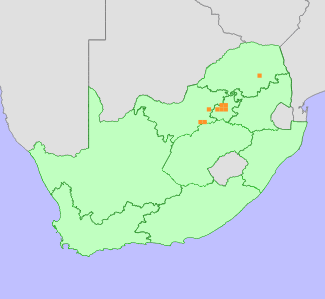|
Scientific Name | Pearsonia bracteata (Benth.) Polhill |
Higher Classification | Dicotyledons |
Family | FABACEAE |
Synonyms | Lotononis bracteata Benth. |
National Status |
Status and Criteria | Near Threatened B1ab(i,ii,iii,iv,v) |
Assessment Date | 2021/05/11 |
Assessor(s) | L. von Staden |
Justification | This species is assessed as Vulnerable because the extent of occurrence (EOO) is 9,767-11,183 km², the area of occupancy (AOO) is 48-312 km², and it is estimated to occur in eight to eleven locations that are under continuing decline due to ongoing habitat loss to urban development, agriculture and mining in Gauteng and North West. |
Distribution |
Endemism | South African endemic |
Provincial distribution | Gauteng, Limpopo, North West |
Range | Wolkberg and Pretoria to Klerksdorp. |
Habitat and Ecology |
Major system | Terrestrial |
Major habitats | Vaal Reefs Dolomite Sinkhole Woodland |
Description | Plateau grassland. |
Threats |
| Southern populations in Gauteng and North West are threatened by habitat loss to agriculture, urban expansion, mining, quarrying and alien invasive plants. Plants in the Wolkberg occur in more remote areas where they are unlikely to be threatened, except in the Downs area where agriculture, grazing and alien invasive plants are a potential threat. |
Population |
Population decline is inferred from ongoing habitat loss at most of the known localities in Gauteng and North West. Plants in the Wolkberg are not suspected to be declining.
|
Population trend | Decreasing |
Notes |
| This species has a large disjunction in its distribution. It appears to be most common in the area between Pretoria, Brits and Krugersdorp. When the genus was last revised (Polhill 1974), Polhill noted that a single specimen from The Downs in the Wolkberg were placed with this species, but with uncertainty. Subsequently more material was collected from the Wolkberg, but none in intervening areas. Plants in Gauteng and North West occur in gently sloping Highveld grassland, while those in the Wolkberg were collected from steep wooded slopes and cliffs in river valleys. Given the large disjunction and difference in habitat preference, it is worth investigating whether this species concept does not represent two subspecies or perhaps even two separate species, in which case Pearsonia bracteata would be a range-restricted, very threatened species, qualifying as either Endangered or Vulnerable. |
Assessment History |
Taxon assessed |
Status and Criteria |
Citation/Red List version | | Pearsonia bracteata (Benth.) Polhill | Least Concern | Raimondo et al. (2009) | |
Bibliography |
Polhill, R.M. 1974. A revision of Pearsonia (Leguminosae-Papilionoideae). Kew Bulletin 29(2):383-410.
Raimondo, D., von Staden, L., Foden, W., Victor, J.E., Helme, N.A., Turner, R.C., Kamundi, D.A. and Manyama, P.A. 2009. Red List of South African Plants. Strelitzia 25. South African National Biodiversity Institute, Pretoria.
|
Citation |
| von Staden, L. 2021. Pearsonia bracteata (Benth.) Polhill. National Assessment: Red List of South African Plants version 2024.1. Accessed on 2025/11/08 |
 Comment on this assessment
Comment on this assessment


